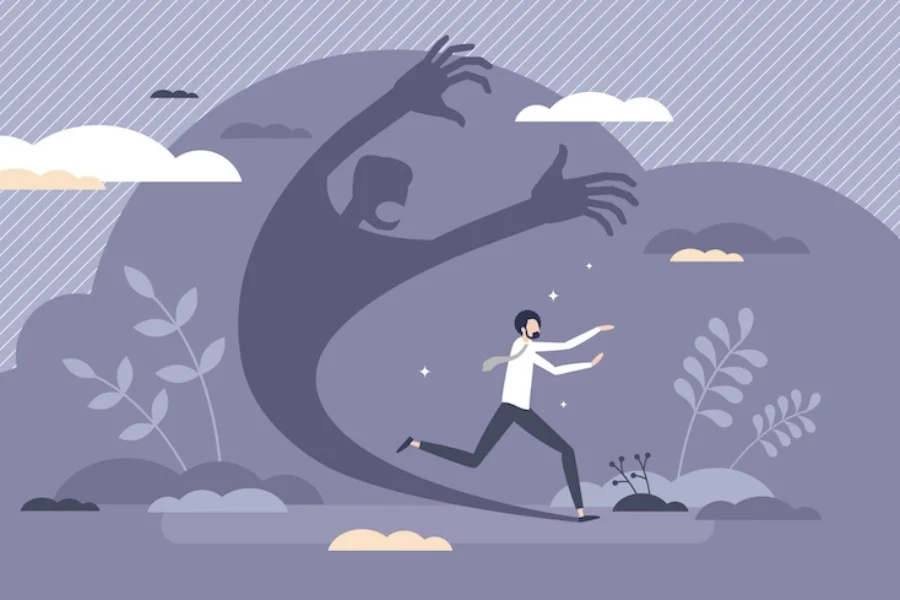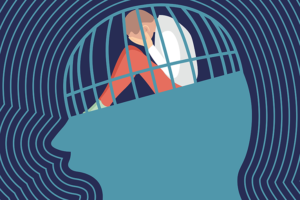By Hilary Jacobs Hendel, LCSW
Anxiety and fear are words often used interchangeably, but they are not the same.
Fear is one of the seven core emotions on the Change Triangle, the practical tool I use to teach emotion education. The biological and evolutionary purpose of core emotions, like fear, is to help us survive. Fear specifically makes us flee from danger.
Anxiety, an inhibitory emotion on the Change Triangle, results from avoiding core emotions and needs. More specifically, anxiety results from the physical effort to push down emotions. If we know we are not in physical danger in a moment, yet we are experiencing something akin to fear, we can assume we are experiencing anxiety.
In general, the amount of anxiety we experience is linked to our early experiences with emotions. For example, if a child “learns” by experience that their sadness leads to mother’s withdrawal or impatience, the child will learn to suppress sadness. In result, the child may feel anxiety instead of sadness.
It’s important to understand the difference between fear and anxiety because the way we work through these two emotions is different.
What Is Fear?
When you feel afraid, the five senses of seeing, hearing, tasting, smelling and touch translate information happening in our immediate environment. For example, when we see a vicious-looking animal running toward us, hear footsteps approaching from behind, smell smoke in our house, or feel unexpectedly touched on the back, the limbic system, simply known as the emotional brain, switches on the fear response.
This happens automatically, which is why we can’t control whether we have emotions, only how we react to them. Core fear causes many changes in the body similar to that of anxiety. That is because fear’s “job” is to get the body ready to fight or flee. Imagine for a minute what happens when we get startled. The mere surprise of a horn, for example, starts our heart racing and our breathing to get shallower and faster. We might jump or flinch. All the physical changes that fear causes promotes a rapid response to danger.
It is worth restating, since many of us blame ourselves for having emotions, that fear and other core emotions are automatic reactions that we cannot prevent. Nature designed us this way for a reason. Bypassing conscious control makes for speedier reactions. Without fear, we’d be easier prey.
What Is Anxiety?
While anxiety and fear feel similar, anxiety is a reaction to our emotions versus danger in the environment. Anxiety is a stop-reaction to the impulses that fear and other core emotions create inside the body. For example, fear mobilizes energy for movement and anxiety pushes it back down. Why would we learn to push down our fear (or other core emotions)? Here are some reasons:
We were told or shown that we were bad or weak for being afraid.
Our fear was unwanted or not permitted by others we needed.
Our fear felt or feels overwhelming and unmanageable.
We could not escape danger at one time.
We have too many emotions at one time to process or understand them.
Our fear conflicts with other emotions, beliefs, values and what others ask of us.
What makes anxiety so confusing is that we can experience it due to something upsetting in the present and we can experience it from something in the past that continues to influences us. Psychotherapy can be helpful in determining what events from the past influence our anxiety in the present.
What Does Fear And Anxiety Feel Like?
All emotions are physical in nature. As a result, we can sense them in the body. If we slow down and notice what happens below the neck during fear or anxiety, we will eventually notice a variety of physical sensations and changes.
The physical manifestations of fear vs anxiety:
Fear
Rapid heartbeat
Shortness of breath
Sweating
Trembling
Chills
Dry mouth
Nausea
Anxiety
Feeling nervous, restless, or tense
Having a sense of doom
Increased heart rate
Shortness of breath
Sweating, Dizziness, Ear ringing
Trouble concentrating
Trouble sleeping
Gastrointestinal (GI) distress
Ruminating
Feeling insecure
You might have noticed that fear and anxiety evoke several similar physical experiences. That’s why they are hard to discern.
How Can I Process Fear And Anxiety?
Core emotions like fear calm down when they are fully and safely experienced in the body — once we no longer feel threatened or in danger. Using deep belly breathing plus a mindful, curious and compassionate stance, we can follow the sensations of fear in the body, like trembling, until they release or dissipate.
Anxiety, on the other hand, needs to be calmed not only to feel better, but to help get us in touch with the core emotions that underlie it.
When working through anxiety, it can be helpful to first find a quiet place to slow down, feel our feet on the ground, and take six or so deep belly breaths. Not only does this set the stage for processing emotions, but it immediately begins to calm anxiety. Then, we must get very curious about what core emotions we might also be experiencing. I ask myself, “Is anything scary or dangerous happening to me right now?” If I am going too fast in my car or boarding an airplane, I might answer “yes” to this question.
If the answer is “no,” I can discern that I’m experiencing anxiety. For example, Steve gets hit with a jolt of what feels like fear every time his boss assigns a task. We determined this was anxiety and not fear. Why? Because doing tasks are not dangerous to survival. However, as a little boy, when Steve made a mistake, he was chastised and humiliated. As an adult, Steve’s mind equates doing tasks with the memory of being shamed, which triggers anxiety.
When working with anxiety, I advise going deeper to see if you can identify one or more core emotions that are underlying the anxiety. Ask yourself, “Do I feel angry? Do I feel sadness? Do I feel afraid? Do I feel disgusted? Do I feel excited? Do I feel joy? Do I feel sexually excited?”
We have power to move through anxiety and fear to increase future well-being. We can work the Change Triangle and learn techniques such as fantasy portrayals and staying with physical sensations to help process fear and other core emotions. These techniques can be used alone or with a support person or professional counsellor who works with emotions in the body.
Try never to judge the emotions you discover within. Instead appreciate them for how they inform us of our humanity and remind us we are alive.
Emotional health is as important as physical health. And, in truth, they are inextricably linked. When we feel anxious or scared, it’s time to understand what is happening so we can respond to our emotions in a way that nurtures both our short- and long-term emotional health.
Hilary is author of the international award-winning book, It’s Not Always Depression: Working the Change Triangle to Listen to the Body, Discover Core Emotions, and Connect to Your Authentic Self (Random House). She received her BA in biochemistry from Wesleyan University and an MSW from Fordham University. She is a certified psychoanalyst and AEDP psychotherapist and supervisor. She has published articles in The New York Times, Time, NBC Think, FOX News, Oprah and her blog is read worldwide.
Source: https://nami.org/Blogs/NAMI-Blog/May-2021/Anxiety-And-Fear-What-s-The-Difference




